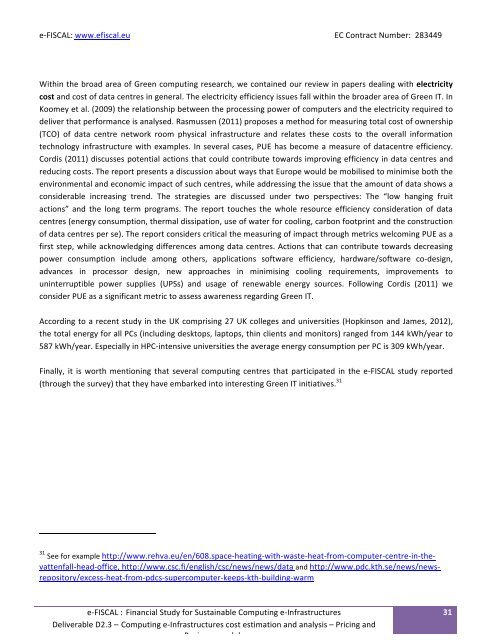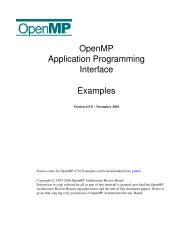D2 3 Computing e-Infrastructure cost calculations and business _models_vam1-final
D2 3 Computing e-Infrastructure cost calculations and business _models_vam1-final
D2 3 Computing e-Infrastructure cost calculations and business _models_vam1-final
You also want an ePaper? Increase the reach of your titles
YUMPU automatically turns print PDFs into web optimized ePapers that Google loves.
e-‐FISCAL: www.efiscal.eu <br />
EC Contract Number: 283449 <br />
Within the broad area of Green computing research, we contained our review in papers dealing with electricity <br />
<strong>cost</strong> <strong>and</strong> <strong>cost</strong> of data centres in general. The electricity efficiency issues fall within the broader area of Green IT. In <br />
Koomey et al. (2009) the relationship between the processing power of computers <strong>and</strong> the electricity required to <br />
deliver that performance is analysed. Rasmussen (2011) proposes a method for measuring total <strong>cost</strong> of ownership <br />
(TCO) of data centre network room physical infrastructure <strong>and</strong> relates these <strong>cost</strong>s to the overall information <br />
technology infrastructure with examples. In several cases, PUE has become a measure of datacentre efficiency. <br />
Cordis (2011) discusses potential actions that could contribute towards improving efficiency in data centres <strong>and</strong> <br />
reducing <strong>cost</strong>s. The report presents a discussion about ways that Europe would be mobilised to minimise both the <br />
environmental <strong>and</strong> economic impact of such centres, while addressing the issue that the amount of data shows a <br />
considerable increasing trend. The strategies are discussed under two perspectives: The “low hanging fruit <br />
actions” <strong>and</strong> the long term programs. The report touches the whole resource efficiency consideration of data <br />
centres (energy consumption, thermal dissipation, use of water for cooling, carbon footprint <strong>and</strong> the construction <br />
of data centres per se). The report considers critical the measuring of impact through metrics welcoming PUE as a <br />
first step, while acknowledging differences among data centres. Actions that can contribute towards decreasing <br />
power consumption include among others, applications software efficiency, hardware/software co-‐design, <br />
advances in processor design, new approaches in minimising cooling requirements, improvements to <br />
uninterruptible power supplies (UPSs) <strong>and</strong> usage of renewable energy sources. Following Cordis (2011) we <br />
consider PUE as a significant metric to assess awareness regarding Green IT. <br />
According to a recent study in the UK comprising 27 UK colleges <strong>and</strong> universities (Hopkinson <strong>and</strong> James, 2012), <br />
the total energy for all PCs (including desktops, laptops, thin clients <strong>and</strong> monitors) ranged from 144 kWh/year to <br />
587 kWh/year. Especially in HPC-‐intensive universities the average energy consumption per PC is 309 kWh/year. <br />
Finally, it is worth mentioning that several computing centres that participated in the e-‐FISCAL study reported <br />
(through the survey) that they have embarked into interesting Green IT initiatives. 31<br />
31 See for example http://www.rehva.eu/en/608.space-‐heating-‐with-‐waste-‐heat-‐from-‐computer-‐centre-‐in-‐the-vattenfall-‐head-‐office,<br />
http://www.csc.fi/english/csc/news/news/data <strong>and</strong> http://www.pdc.kth.se/news/news-repository/excess-‐heat-‐from-‐pdcs-‐supercomputer-‐keeps-‐kth-‐building-‐warm<br />
<br />
e-‐FISCAL : Financial Study for Sustainable <strong>Computing</strong> e-‐<strong>Infrastructure</strong>s <br />
Deliverable <strong>D2</strong>.3 – <strong>Computing</strong> e-‐<strong>Infrastructure</strong>s <strong>cost</strong> estimation <strong>and</strong> analysis – Pricing <strong>and</strong> <br />
Business <strong>models</strong> <br />
31




